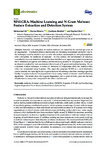MALGRA: Machine Learning and N-Gram Malware Feature Extraction and Detection System
| dc.contributor.author | Ali, M | |
| dc.contributor.author | Shiaeles, S | |
| dc.contributor.author | Bendiab, G | |
| dc.contributor.author | Ghita, B | |
| dc.date.accessioned | 2021-05-18T11:46:57Z | |
| dc.date.available | 2021-05-18T11:46:57Z | |
| dc.date.issued | 2020-10-26 | |
| dc.identifier.issn | 1450-5843 | |
| dc.identifier.issn | 2079-9292 | |
| dc.identifier.other | ARTN 1777 | |
| dc.identifier.uri | http://hdl.handle.net/10026.1/17131 | |
| dc.description.abstract |
<jats:p>Detection and mitigation of modern malware are critical for the normal operation of an organisation. Traditional defence mechanisms are becoming increasingly ineffective due to the techniques used by attackers such as code obfuscation, metamorphism, and polymorphism, which strengthen the resilience of malware. In this context, the development of adaptive, more effective malware detection methods has been identified as an urgent requirement for protecting the IT infrastructure against such threats, and for ensuring security. In this paper, we investigate an alternative method for malware detection that is based on N-grams and machine learning. We use a dynamic analysis technique to extract an Indicator of Compromise (IOC) for malicious files, which are represented using N-grams. The paper also proposes TF-IDF as a novel alternative used to identify the most significant N-grams features for training a machine learning algorithm. Finally, the paper evaluates the proposed technique using various supervised machine-learning algorithms. The results show that Logistic Regression, with a score of 98.4%, provides the best classification accuracy when compared to the other classifiers used.</jats:p> | |
| dc.format.extent | 1777-1777 | |
| dc.language | en | |
| dc.language.iso | en | |
| dc.publisher | MDPI AG | |
| dc.subject | malware | |
| dc.subject | dynamic analysis | |
| dc.subject | sandbox | |
| dc.subject | SNDBOX | |
| dc.subject | N-grams | |
| dc.subject | API call | |
| dc.subject | machine learning | |
| dc.subject | Logistic Regression | |
| dc.subject | Naive Bayes | |
| dc.subject | Random Forests | |
| dc.subject | Decision Tree | |
| dc.title | MALGRA: Machine Learning and N-Gram Malware Feature Extraction and Detection System | |
| dc.type | journal-article | |
| dc.type | Journal Article | |
| plymouth.author-url | https://www.webofscience.com/api/gateway?GWVersion=2&SrcApp=PARTNER_APP&SrcAuth=LinksAMR&KeyUT=WOS:000592765700001&DestLinkType=FullRecord&DestApp=ALL_WOS&UsrCustomerID=11bb513d99f797142bcfeffcc58ea008 | |
| plymouth.issue | 11 | |
| plymouth.volume | 9 | |
| plymouth.publication-status | Published online | |
| plymouth.journal | Electronics | |
| dc.identifier.doi | 10.3390/electronics9111777 | |
| plymouth.organisational-group | /Plymouth | |
| plymouth.organisational-group | /Plymouth/Faculty of Science and Engineering | |
| plymouth.organisational-group | /Plymouth/Faculty of Science and Engineering/School of Engineering, Computing and Mathematics | |
| plymouth.organisational-group | /Plymouth/REF 2021 Researchers by UoA | |
| plymouth.organisational-group | /Plymouth/REF 2021 Researchers by UoA/UoA11 Computer Science and Informatics | |
| plymouth.organisational-group | /Plymouth/Users by role | |
| plymouth.organisational-group | /Plymouth/Users by role/Academics | |
| dcterms.dateAccepted | 2020-10-17 | |
| dc.rights.embargodate | 2021-6-8 | |
| dc.identifier.eissn | 2079-9292 | |
| dc.rights.embargoperiod | Not known | |
| rioxxterms.versionofrecord | 10.3390/electronics9111777 | |
| rioxxterms.licenseref.uri | http://www.rioxx.net/licenses/all-rights-reserved | |
| rioxxterms.licenseref.startdate | 2020-10-26 | |
| rioxxterms.type | Journal Article/Review |


